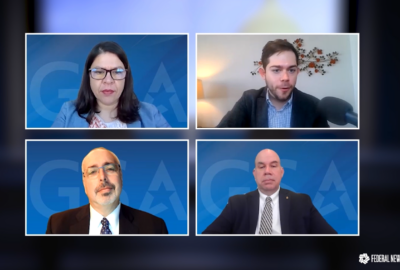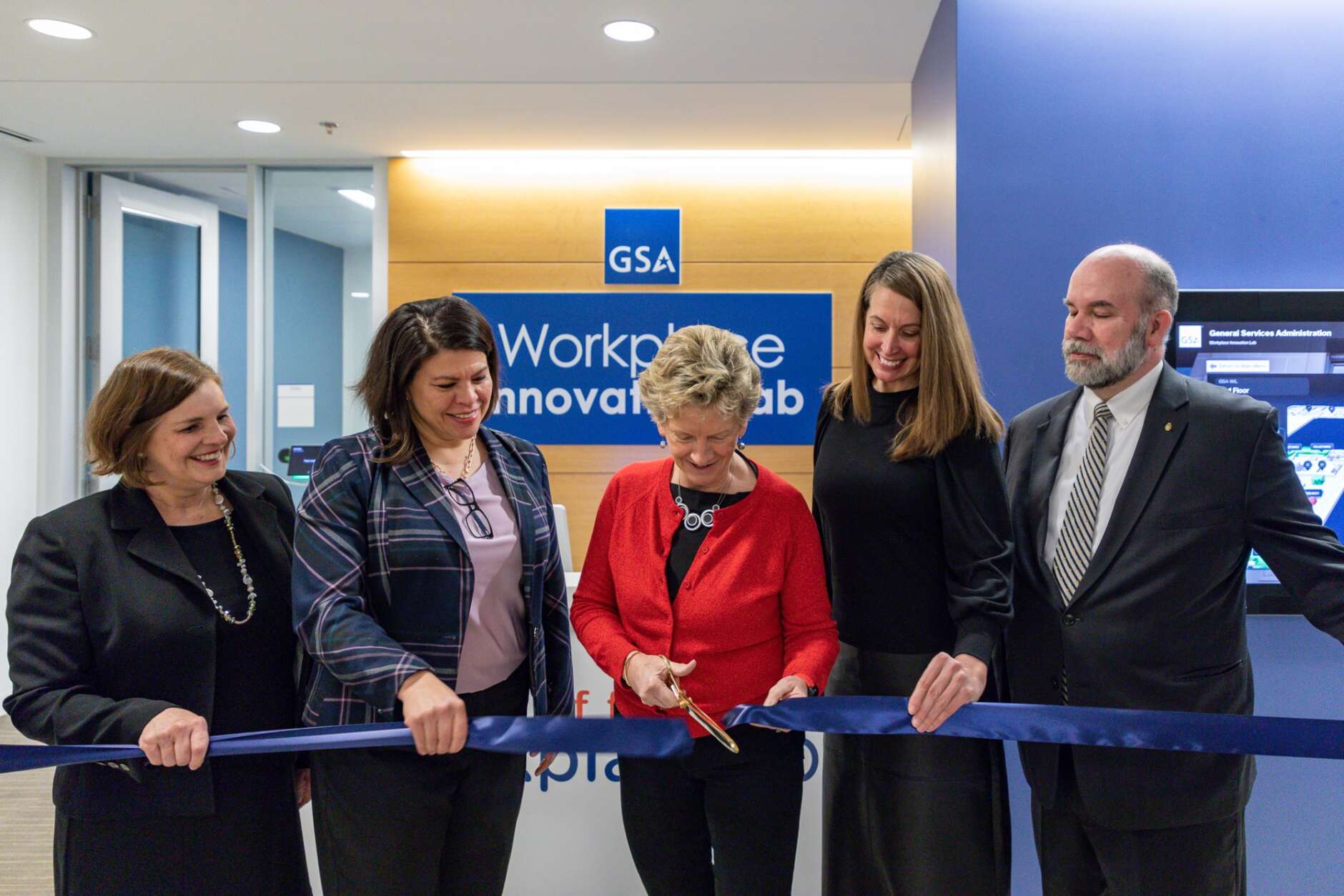

Hubbard Radio Washington DC, LLC. All rights reserved. This website is not intended for users located within the European Economic Area.
The General Services Administration unveiled its Workplace Innovation Lab at its headquarters in Washington, D.C. with five furniture vendors to demonstrate wha...

GSA Administrator Robin Carnahan (center) cuts the ribbon along with (from left) Commerce Department’s Lisle Hannah, the director of the Office of Facilities and Environmental Quality, Nina Albert, the commissioner of GSA’s Public Building Service, Katy Kale, GSA’s deputy administrator, and Chuck Hardy, GSA’s chief architect, of the new Workplace Innovation Lab at the agency’s headquarters building in Washington, D.C. (Photo courtesy GSA).
The federal office of the future will not be done to employees, but will be led by employees.
That is the General Services Administration’s goal with its new Workplace Innovation Lab, unveiled Jan. 25 in Washington D.C.
“The innovation lab is one of the many ways that we are seeking to create the magnet, not the mandate, for people to return to office and to re-experience the benefits of shared culture, idea exchange and camaraderie,” said Nina Albert, the commissioner of the Public Building Service at GSA, during the grand opening celebration. “What you’re going to see today are just innovations: innovations in furniture solutions, innovations in conferencing, how really can we experience hybrid in a way that feels seamless and effortless as opposed to a burden.”
The year-long project brought together five furniture vendors and one technology provider to offer agencies the opportunity to test out and provide feedback on new and different office space designs, a key piece of the broader Workplace 2030 initiative. GSA is accepting reservations for agencies to test out the lab and to provide tours.

Albert said the difference between Workplace 2030 and previous attempts prior to 2010 and 2020 is the focus on the user.
“There’s an interesting history of what the assumptions were back in the 1950s, and how people wanted to work. Then we moved to a density model where everybody’s packed in and cubicle stations and open areas,” she said. “Now the future is about choice. People can work in an enclosed office. We call it a focus room when they need to do kind of heads down work or one-on-one work. Or they can work in an open office space because your day shifts and what you need at that moment shifts even on a daily basis.”
When GSA launched workplace 2020 in the mid-2000s and started shifting employees and tenants to the open office concept, employees felt the change was being done to them versus with them.
Many employees withdrew behind earbuds or pushed for more pre-pandemic telework to get away from the person who wears too much perfume or the person who eats tuna every day at their desk for lunch.
GSA changed its approach to Workplace 2030 by meeting with more than 100 employees from 18 agencies starting in 2021, to discuss what the future of federal workspace would look like.
Albert said GSA created the lab to show how the pandemic spurred innovation in the office space sector, as well as for agencies to see what is possible without having to spend any money.
“There’s a section of the innovation lab that I think is pretty cool. It showcases home technology solutions. But really, the majority of the lab is focused on office solutions,” she said. “Specifically, the themes that I keep looking at and keep resonating in every conversation that I have about what the future workplace might be is around mobility and flexibility. You’ll see movable, modular furniture that reflects that need to experiment in the next couple more years until people figure out what that new normal mode of working is for their team. You’re also going to see furniture that’s a little bit more relaxed, so that people can bring that living room comfort to the office. There’s lots of different varieties of space and that’s because the future of the workplace is about providing employees with a lot of different choices.”
That choice that Albert described was on display in the lab in several different ways.
The vendors brought in desks on wheels that can be moved from one person, who is in heads down mode, set up to a two-person collaboration session.
There are nearly sound proof booths, similar to the phone booths of old, where a worker can hideaway to take a personal call or do a quick video session without disturbing others.
There also are couches, stools and assorted other types of seating and tables that one may find at home or at a coffee shop.
Each of these workspaces have leading edge hardware and software. Touch screens to make reservations for a conference room or a desk area, details about heating or cooling of that specific space and multiple screens, and speakers and cameras to make it easy for the employee to participate in online meetings.
Chuck Hardy, GSA’s chief architect, said each of the five vendors approached their part of the 25,000 square foot space differently.
“There’s a lot of touchscreens that you can log in to whatever your brand of meeting is, whether it’s Zoom or Google or Teams or whatever, it makes it an easy one-touch activity,” he said. “The other thing you’re seeing in some of these products is sound cancellation. We can be in this room having this conversation in an open area, so if you think about your AirPods that cancel out the sound around you, these technologies do that as well. It focuses on the three people in the meeting and the 10 people that are next door, blocks out and cancels their sound. We showed a demonstration where it actually canceled out a firetruck going down the street while you’re having a meeting.”
Hardy said GSA expects the participating vendors to continually innovate these spaces over the next year based on the feedback they receive.
“We’re looking for feedback. We’re looking for the vendors, if they choose, to do those contemporaneous adjustments to the space to see if they can improve it by just moving the current product around or, potentially, even bringing in additional product to solve whatever those issues are,” he said. “We want the folks using the space to say, ‘this is what we like about it. Let’s keep this. Or this is something we probably wouldn’t use.’ That’s what will be challenging the industry to see what they can do.”
Hardy said GSA will collect feedback about the innovation lab set-ups in several different ways. The reservation system will ask users to take a survey. GSA plans to do follow-up calls as well with users.
“Over the year, we’re right now in discussions about having roundtables of people that use it to say let’s bring some people in and have a conversation about how it worked or not. So we can elicit some in person feedback,” he said. “The vendors are also looking in their way of gathering research and data that they do on a regular basis as well. It’s all about improving the product and improving the experience.”
GSA also is making it easy for agencies to take part as there is no cost to work in the lab. Federal employees also will find it less complicated to visit the lab because GSA is simplifying how non-agency federal employees can get into the building.
GSA Administrator Robin Carnahan said with more than 8,600 buildings around the country and 370 million square feet of space, the innovation lab will influence the way GSA creates the office space of today and the future.
“I could not be more excited because the timing of this is perfect. Because every agency across government is right now is thinking about their space needs. They’re rethinking what this is all looking like,” she said. “So for GSA to be able to be out front, provide what’s possible, provide these options in a way that’s very flexible and easy to use, I think it’s just another example of our team leading the way in this important change.”
The Office of Management and Budget required agencies to submit by Dec. 16 their capital plan for 2024 to 2028 that detailed how much and what types of properties and office space will be necessary to meet their goals around the future of work.
Carnahan said more than 200 employees from across the government already have come through the workplace innovation lab. And she expects the traffic only to increase in the coming months.
“We know that because our federal agency partners have so many different missions and people that they serve, it’s going to look different for each agency. What is going to be the same, though, is it’s empowering our teams so that they have the tools that they need to do their best work for the people that we serve as our North Star,” Carnahan said. “The platforms, that the technology, that the setups all are going to matter, that we’re going to have to be intentional about making sure that we have spaces that create meaningful interactions for people to come in to offices. It’s not going to make a lot of sense if we just have the same old configurations and people sit in an office by themselves on a call video with worse internet than they have at home. We have got to have a setup that encourages this kind of collaboration and empowerment, that creates those flexible workspaces, that they can do those jobs.”
Copyright © 2024 Federal News Network. All rights reserved. This website is not intended for users located within the European Economic Area.
Jason Miller is executive editor of Federal News Network and directs news coverage on the people, policy and programs of the federal government.
Follow @jmillerWFED




Daily photos of things happening in and around the federal government.
